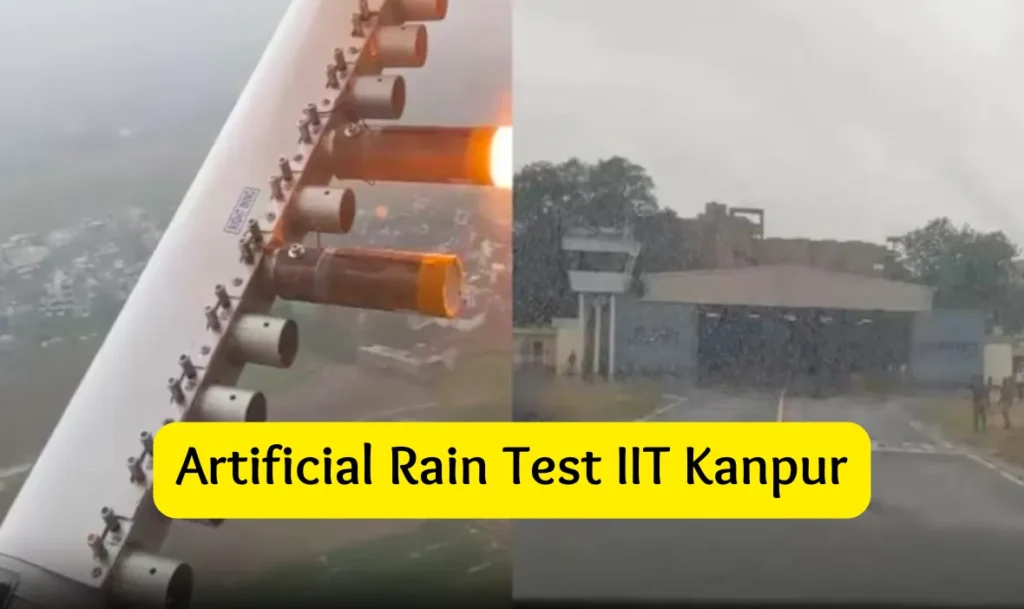Artificial Rain Test IIT Kanpur 2023 – As per our readers’ demand and comments, we are publishing this article. If you want to know about Artificial Rain Test IIT Kanpur, continue reading and learn more.
जाने इस पोस्ट में क्या क्या है
Artificial Rain Test IIT Kanpur
The Indian Institute of Technology-Kanpur (IIT-K) has successfully tested artificial rain or cloud seeding technology after years of dedicated efforts.

The test was conducted over a limited area on the sprawling campus, where a plane flew to a height of 5,000ft from the institute’s airstrip, firing powder spray amid thick clouds, which resulted in heavy rain. The project was spearheaded by Manindra Agrawal, professor, department of Computer Science and Engineering, IIT Kanpur, who said that “our capabilities in this direction have been successfully tested”.
The successful test is expected to help Uttar Pradesh’s parched Bundelkhand region with artificial rains. It took IIT-Kanpur six years to make this happen, after the Uttar Pradesh government reached out to help Bundelkhand with artificial rains in 2017. The test has been widely covered by Indian news channels and media outlets.
| Institution | Indian Institute of Technology-Kanpur (IIT-K) |
| Technology | Artificial rain or cloud seeding |
| Location | IIT-K campus |
| Method | A plane flew to a height of 5,000ft from the institute’s airstrip, firing powder spray amid thick clouds |
| Result | Heavy rain |
| Lead Scientist | Manindra Agrawal, professor, department of Computer Science and Engineering, IIT Kanpur |
| Impact | Expected to help Uttar Pradesh’s parched Bundelkhand region with artificial rains |
| Timeframe | 6 years, from 2017 to 2023 |
| Coverage | Widely covered by Indian news channels and media outlets |
What is cloud seeding and how does it work?
Cloud seeding is a weather modification technique that aims to change the amount or type of precipitation that falls from clouds by introducing tiny ice nuclei into certain types of subfreezing clouds. The process involves implanting clouds with particles such as silver iodide crystals, which act as an ice-forming nuclei to aid in the production of snowflakes.
Cloud seeding can modify clouds and induce rain by producing rain when none would fall naturally or by increasing the amount of rain that falls over a particular area. Cloud seeding is usually carried out by sprinkling particles from a plane. The newly formed snowflakes quickly grow and fall from the clouds back to the surface of the Earth, increasing snowpack and streamflow. Cloud seeding relies on a number of factors to be in place before it can be considered a cost-effective water supply solution.
These factors include the existence of clouds, suitable weather conditions, and the location of the target area and the prevailing winds. Cloud seeding is only effective in certain locations in a limited number of weather conditions. Cloud seeding can also be used to manage hail by increasing the number of ice pellets in hail-producing clouds and decreasing the size of each pellet, which reduces the damage caused by hail.
What was the purpose of the artificial rain test conducted by IIT Kanpur?
The purpose of the artificial rain test conducted by IIT Kanpur was to test the cloud seeding technology that aims to change the amount or type of precipitation that falls from clouds by introducing tiny ice nuclei into certain types of subfreezing clouds.
The successful test opens up possibilities for creating rainfall in drought-prone regions of Uttar Pradesh, offering hope for agricultural communities facing water scarcity. The test was conducted over a limited area on the sprawling campus, where a plane flew to a height of 5,000ft from the institute’s airstrip, firing powder spray amid thick clouds, which resulted in heavy rain.
The project was spearheaded by Manindra Agrawal, professor, department of Computer Science and Engineering, IIT Kanpur, who said that “our capabilities in this direction have been successfully tested”. The successful test is expected to help Uttar Pradesh’s parched Bundelkhand region with artificial rains.
What are the potential benefits of cloud seeding technology?
Cloud seeding technology has several potential benefits, including:
Advantages:
- Limiting famine and reducing drought by creating better freshwater resources.
- Creating more winter snowfall and leading to more mountain snowpack.
- Enhancing the natural water supply to communities.
- Making dry places more livable.
- Reducing crop damage.
- Boosting the economy by creating more employment opportunities and increasing tourism.
- Improving biomes, allowing for more fertility and creating more farming land and land that could be used to build better homes.
Disadvantages:
- Cloud seeding is not a guaranteed solution and its effectiveness depends on several factors.
- The full impact of cloud seeding is still not fully known.
- Cloud seeding can be expensive.
- It can have unintended consequences, such as changing the weather patterns in unintended ways.
- It can lead to environmental damage.
- It can be difficult to measure the effectiveness of cloud seeding.
Overall, cloud seeding has the potential to offer several economic opportunities that can improve the quality of life for the impacted community. However, extensive research should be conducted before introducing nationwide cloud seeding programs in developing countries, and the potential negative impacts should be carefully considered.
Read More
- Vanshavali Format In Bihar Pdf Download – Very Useful
- Union Bank of India Apprentices Recruitment 2024 Notification Out: यूनियन बैंक ऑफ इंडिया में अप्रैंटिश के कुल 500 पदों पर निकली नई भर्ती
- Bihar Beltron DEO Admit Card 2024 Download Link Exam Date Released (Date Entry Operator)
- Post Office Agent Recruitment 2024: 10वीं पास के लिए पोस्ट ऑफिश एजेंट के पद पर बिना परीक्षा डायरेक्ट भर्ती, ऐसे करें आवेदन
- Bihar Deled Spot Admission 2024: बिहार डी.एल.एड. स्पॉट एडमिशन शुरू -@deledbihar.com




